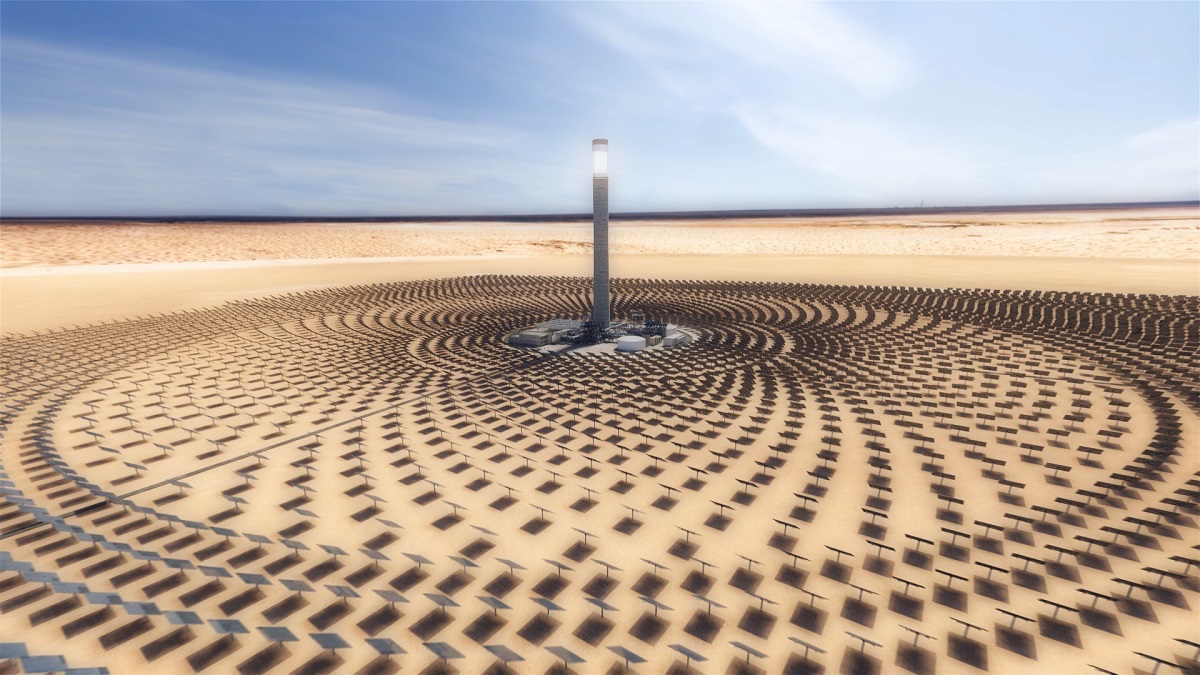
IMAGE CREDIT: SENER Ouarzazate will be the largest CSP complex in the world upon completion
Morocco’s first operating CSP plant has shown that concentrating solar power can solve the problem of energy blackouts in the peak evening hours, a senior representative of the Moroccan Agency for Sustainable Energy (MASEN) told the recent CSP Seville conference.
The 160 MW Noor 1 parabolic trough power plant exceeded its objectives in year one and brought stability to the grid, according to Abdelkader Himdi, Director of Operations and Maintenance at MASEN. The region around Noor 1 has seen a “drastic improvement on the quality of service, there are no more blackouts with Noor 1 operating,” he said.
The Ouarzazate CSP complex at the junction of the Atlas Mountains and Sahara Desert will be the largest CSP complex in the world upon completion. Noor 2 and Noor 3, the second and third phases, will have 200 MW and 150 MW capacity respectively. Noor 1 has three hours thermal energy storage. Noor 2, also based on parabolic trough technology, will have six hours storage, and Noor 3, with its 250m power tower, will have seven-and-a-half hours storage. Noor 1 provides electricity for 115,000 homes, and Noor 2 and 3 are expected to provide for an additional 280,000 homes.
Morocco, with a population of 35 million people, has set what Himdi called “very aggressive” renewables objectives. It aims to have 42% of installed energy capacity coming from renewables by 2020, and for this to increase to 52% by 2030. MASEN was established in 2013 to develop and manage 2,000 MW of solar power plants.
The government does “not care” which technologies go into making up the overall renewables mix, and is focused only on solutions to Morocco’s problems of being overly reliant on the importation of fossil fuels, Himdi said.
Getting the storage right
Sergio Relloso, Performance Guarantee Manager at SENER, EPC partner to all three phases of the Ouarzazate project, said one of the main lessons to come out of Noor 1 was the need to have at least six storage hours built into the plants. The tender for Noor 1 required that the joint venture partners – SENER, along with Saudi Arabia’s ACWA and fellow Spanish firms TSK and Acciona – implement only three hours storage. At Noor 2 and Noor 3, the designers were free to decide how much storage they wanted.
Typical peak load hours are 7pm to midnight in summer, and 5-10pm in winter, he said. “There are no issues in summer, because we have plenty of energy. But in winter, it’s the turbine component that adapts to the variations in output from the solar field.”
Relloso said SENER’s projects in Spain produce at a maximum load and the storage absorbs the variation from the solar field. In Morocco, he said, they had to adapt their strategy to maximize production during peak time.
At Noor, “we charge at full load, maximum charging rate from storage, as much as we can, and the rest of the energy that the storage cannot admit goes to to the turbine; the turbine absorbs the variations of the solar field. It’s the output of the tower that absorbs the variations… This is a clear example of how the plant can adapt to provide energy inside peak hours,” Relloso said.
Becoming energy independent
The Climate Investment Funds provided $435 million in concessional financing for Ouarzazate. This was then used to leverage more than $3 billion from other financing institutions including the World Bank Group and the African Development Bank (AfDB). Last month, the AfDB committed an additional $265 million to the development of the Noor projects.
Stratos Tavoulareas, Senior Energy Advisor International Finance Corporation, who spoke on general terms about concessional financing to the Seville conference, said developing countries should accept such financing for the first three to four projects. Later, once it is established that CSP or other renewables technologies can stand on their own, a country should no longer apply for such financing, he said.
Electricity generated by Noor 1 costs $240/MWh, reduced to $180/MWh when factoring in concessional financing, ACWA Power’s Paddy Padmanathan has previously stated. Noor 2 will produce at a significantly lower cost than Noor 1: $190/MWh before factoring in concessional financing.
In Seville, Himdi admitted the price was still high, and said the challenge is to ensure that reducing costs is not a one-off, but can be done in a more consistent way to bring costs to parity with the global average or better.
Himdi and Relloso also described the benefits these projects have for the local population. Ouarzazate is a remote and poor area, even by Moroccan standards, where GDP per capita across the country is less than $3,000 per person. At Noor 1, 70-80 people are employed in operations and maintenance, and an additional 50 in other direct employment such as security, cleaning and temporary maintenance. In preparation for Noor 2 and Noor 3, SENER and the authorities have an agreement to train locals. At Noor 1, 30% of people employed at the plant are locals; at Noor 2 and Noor 3, the target is 35%.
“This is a tricky subject. We can’t just impose and say you need a minimum,” Himdi said. “What we have been trying to do is prepare local companies to be able to catch the opportunities created by these projects. There is some work to be done with local companies, and also to encourage the EPC developers to help these companies take part in the project and have the maximum impact.”
Source: New Energy Update: CSP puts end to Morocco electricity blackouts














































